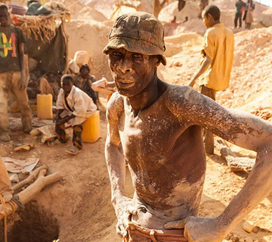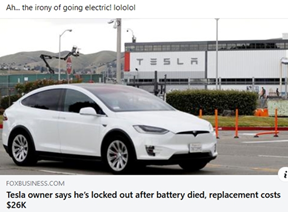I think the only people who can dream about what is referred to as a “green future” in transport can only do so because they must be asleep.
Surely an electric car in every garage and a chicken in every pot is the goal for a modern man or perhaps swap the chicken out for an insect-based protein bar and we have a sustainable future?
Someone else can cover the pros and cons of an insect-based diet whilst I will shine a light on the list of electric car pros and cons.
Lead batteries are way too heavy to power mobile electronic units like phones and cars but, fortunately, lithium batteries are not. A spoonful of lithium is enough to power up the average phone for several years but to power up a car, … well you need a bit more. Chile has the greatest lithium reserves with an estimated 8 million tons. Australia’s Mount Cattlin Lithium mine in Western Australia has the second largest reserve, although it currently produces the most product with about 2.7 million tons. Argentina has another 2 million tons and China has another 1 million tons.
So, there is plenty for everyone correct …? With an S Model Tesla battery pack weighing in at 540kg, … … Nope, there is nowhere near enough.
There is always another mousetrap on the drawing board, perhaps another energy storage source will arise, but a serious under supply of lithium to make worldwide electric vehicle transport a reality is only a mere detail. Lithium-ion batteries became commercially available in 1991 and in the short term there is suffice even at the accelerating demand for lithium. Lithium makes up around 0.0065% of the earth’s crust so cannot technically be considered a rare earth metal or rare earth element.
 Lithium can be found as a 1% orebody being that 100 tonnes of ore needs to be processed to get 1 tonne of product although strip mining may require as much as 1000 tons of earth to product 1 ton of lithium. Ideally mining 5.3 tonnes of lithium carbonate may yield one tonne of lithium but even then, there is further processing including an electrolysis process required to obtain the necessary acceptable purity levels and lithium is not the only metal required in a lithium battery which also needs to be sourced, mined and processed.
Lithium can be found as a 1% orebody being that 100 tonnes of ore needs to be processed to get 1 tonne of product although strip mining may require as much as 1000 tons of earth to product 1 ton of lithium. Ideally mining 5.3 tonnes of lithium carbonate may yield one tonne of lithium but even then, there is further processing including an electrolysis process required to obtain the necessary acceptable purity levels and lithium is not the only metal required in a lithium battery which also needs to be sourced, mined and processed.
The cobalt and manganese that are also required in the manufacture of lithium batteries, are similarly mined and extensively processed to achieve purification levels. Unfortunately, that’s not the end of the game. The extracted metal has to be transported from its location and shipped to where it is processed into a battery, which possibly may be China, and then transported further to where the battery is put into a device such as something as small as a telephone or as large as a motor vehicle, possibly built in the Tesla factory in Texas in the United States, and, then transported to its final destination which could be anywhere in the world including the United States, Europe or Asia. The energy used for transport is predominantly what is referred to as fossil fuels, that is petrol or diesel. Once in the hand of the consumer over 80% of these batteries are charged from a wall socket which is supplied by electrical power from a coal fired power station.
Just before we leave the lithium mine, a google search asking, “Is lithium mining bad for the environment?” returns “Lithium mining destroys the soil structure and leads to unsustainable water table reduction. too dry and exposing In the end, it depletes water resources, leaving the land ecosystems to the risk of extinction”. That doesn’t sound good, … nor does it sound green.
From this site https://www.onio.com/article/environmental-cost-of-batteries.html
Lithium mining unleashes untold levels of destruction in the areas surrounding the mines – The ramifications often devastate huge portions of the environment, often spanning a radius of hundreds of kms”. I have included photo 1 in this article from this site and also include the link advising of the “grave environmental cost associated with Lithium mining.
The mining of cobalt, a key component in lithium-ion battery manufacturing, is another ugly issue, over 70% of the world’s cobalt is mined in the Democratic Republic of Congo where child labour is used in unregulated and unsafe “artisanal”, or small scale mining ventures. As much as 30% of the cobalt mined in the Congo comes from artisanal mining where 40 000 children some as young as six years old work in an unregulated industry of 200 000 miners. The little kids can access tight areas that adults cannot mine and they do so without safety attire, masks, gloves or even shovels and frequently obtain ore with their bare hands often in extreme heat and under precarious conditions. These work conditions that supply cobalt for the lithium batteries have the batteries referred to as “blood batteries”. Whilst cobalt miners working in large scale mining operations are supplied with personal protective equipment and get “fair renumeration” for their work in the order of $3.50 per day, 20% of artisanal workers are children who work in unsafe and unregulated conditions for between .75 cents and $2.00 per day.
Electric vehicles are still being built and promoted whilst lithium supply chains exist, but there are the other “not so green” issues to be considered in this green dream that are quite the nightmare.
The second law of thermodynamics dictates that everything has a functional lifespan so eventually any lithium battery will reach its life expectancy, as does every other product, and is no longer functional.
What do we do with spent lithium-ion batteries?
We are green so we recycle them of course.
No, we don’t.
In a speech given in parliament, by Senator Gerad Rennick, link https://www.facebook.com/watch/?v=406218794890649 advised that the head of the CSIRO, Larry Marshall, stated that it costs 3 times more to recycle a lithium battery than the value of the material that can be extracted from the battery.
That is, it’s not economically viable to recycle lithium batteries.
That doesn’t sound green.
Read more here : https://www.power-technology.com/analysis/lithium-battery-recycling-in-australia/
They cannot be burned safely as that produces more than 100 toxic gases that can be fatal if inhaled. If the lithium battery in your scooter catches on fire, run away and do not be involved in a motor vehicle accident in an electric car that may puncture a battery. Should this happen and a fire from a punctured battery occurs, under no circumstances put water anywhere new the fire as lithium reacts violently with water producing lithium hydroxide and hydrogen which is a flammable gas.
Well, we can simply chuck them in a land fill.
Lithium is corrosive to the skin, so best not to mine using your hands like tens of thousands of kids from the Congo. Placing spent lithium batteries carefully in a land fill, so as not to rupture them, well away from water and somewhere where they will not be affected by fire sounds like a possible option.
Googling “What happens to lithium-ion batteries in landfills”? advises
“When we add old batteries and products embedded with lithium-ion batteries to landfills, they can leach toxic, corrosive chemicals such as mercury, cadmium, lead and nickel into the soil and water table, which endangers the environment and human health. These chemicals are extremely difficult and expensive to clean up”.
I’d like this paper to have a happy ending but from “go to woe”, the journey appears to be plagued with environmental and moral issues.
Can electric vehicles reduce world pollution?
Yes, … but only in a dream.
Regards
John Lynn
https://www.facebook.com/watch/?v=851301779332883
